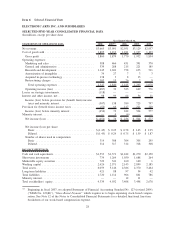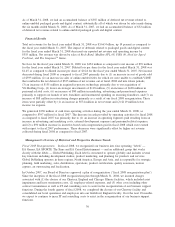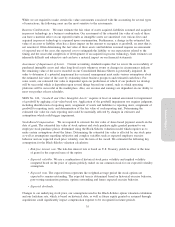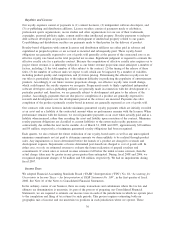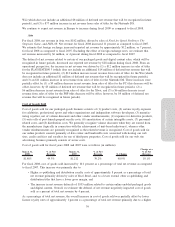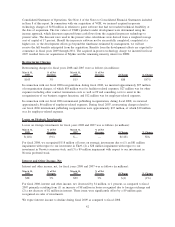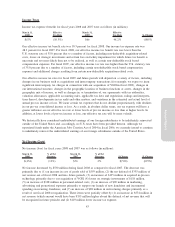Electronic Arts 2008 Annual Report Download - page 112
Download and view the complete annual report
Please find page 112 of the 2008 Electronic Arts annual report below. You can navigate through the pages in the report by either clicking on the pages listed below, or by using the keyword search tool below to find specific information within the annual report.Royalties and Licenses
Our royalty expenses consist of payments to (1) content licensors, (2) independent software developers, and
(3) co-publishing and distribution affiliates. License royalties consist of payments made to celebrities,
professional sports organizations, movie studios and other organizations for our use of their trademarks,
copyrights, personal publicity rights, content and/or other intellectual property. Royalty payments to indepen-
dent software developers are payments for the development of intellectual property related to our games.
Co-publishing and distribution royalties are payments made to third parties for the delivery of product.
Royalty-based obligations with content licensors and distribution affiliates are either paid in advance and
capitalized as prepaid royalties or are accrued as incurred and subsequently paid. These royalty-based
obligations are generally expensed to cost of goods sold generally at the greater of the contractual rate or an
effective royalty rate based on the total projected net revenue. Significant judgment is required to estimate the
effective royalty rate for a particular contract. Because the computation of effective royalty rates requires us to
project future revenue, it is inherently subjective as our future revenue projections must anticipate a number of
factors, including (1) the total number of titles subject to the contract, (2) the timing of the release of these
titles, (3) the number of software units we expect to sell which can be impacted by a number of variables,
including product quality and competition, and (4) future pricing. Determining the effective royalty rate for
our titles is particularly challenging due to the inherent difficulty in predicting the popularity of entertainment
products. Accordingly, if our future revenue projections change, our effective royalty rates would change,
which could impact the royalty expense we recognize. Prepayments made to thinly capitalized independent
software developers and co-publishing affiliates are generally made in connection with the development of a
particular product and, therefore, we are generally subject to development risk prior to the release of the
product. Accordingly, payments that are due prior to completion of a product are generally expensed to
research and development over the development period as the services are incurred. Payments due after
completion of the product (primarily royalty-based in nature) are generally expensed as cost of goods sold.
Our contracts with some licensors include minimum guaranteed royalty payments which are initially recorded
as an asset and as a liability at the contractual amount when no performance remains with the licensor. When
performance remains with the licensor, we record guarantee payments as an asset when actually paid and as a
liability when incurred, rather than recording the asset and liability upon execution of the contract. Minimum
royalty payment obligations are classified as current liabilities to the extent such royalty payments are
contractually due within the next twelve months. As of March 31, 2008 and 2007, approximately $10 million
and $9 million, respectively, of minimum guaranteed royalty obligations had been recognized.
Each quarter, we also evaluate the future realization of our royalty-based assets as well as any unrecognized
minimum commitments not yet paid to determine amounts we deem unlikely to be realized through product
sales. Any impairments or losses determined before the launch of a product are charged to research and
development expense. Impairments or losses determined post-launch are charged to cost of goods sold. In
either case, we rely on estimated revenue to evaluate the future realization of prepaid royalties and
commitments. If actual sales or revised revenue estimates fall below the initial revenue estimate, then the
actual charge taken may be greater in any given quarter than anticipated. During fiscal 2008 and 2006, we
recognized impairment charges of $4 million and $16 million, respectively. We had no impairments during
fiscal 2007.
Income Taxes
We adopted Financial Accounting Standards Board (“FASB”) Interpretation (“FIN”) No. 48, “Accounting for
Uncertainty in Income Taxes — An Interpretation of FASB Statement No. 109”, in the first quarter of fiscal
2008. See Note 10 of the Notes to Consolidated Financial Statements.
In the ordinary course of our business, there are many transactions and calculations where the tax law and
ultimate tax determination is uncertain. As part of the process of preparing our Consolidated Financial
Statements, we are required to estimate our income taxes in each of the jurisdictions in which we operate prior
to the completion and filing of tax returns for such periods. This process requires estimating both our
geographic mix of income and our uncertain tax positions in each jurisdiction where we operate. These
36




